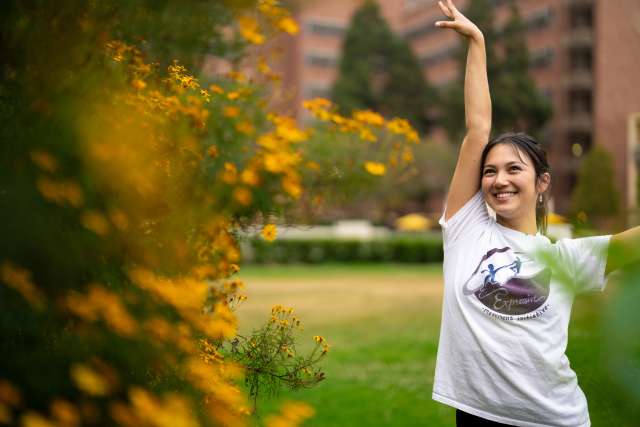“Paint the bubble,” 21-year-old Gabi Hernandez says, her enthusiasm palpable through the Zoom screen. Stretching her arms overhead, the UCLA student sweeps her hands across the imaginary bubble she’s pretending to be inside.
Ten students – all young people with neurodevelopmental disabilities, each in their own home – do the same, moving their arms and hands above them, around them and behind them.
“Now paint the bubble with your feet!” says Hernandez, a volunteer instructor with UCLA’s Expressive Movement Initiative. She and the young dancers bend their knees and wield their feet like paintbrushes. The tinkling piano melody of “Mr. Moustafa” by Alexandre Desplat plays as they twist and move.
Far more than just a fun way to spend an hour a week, this therapeutic virtual dance program significantly improves participants’ motor skills and even boosts social skills, according to a led by , a pediatric neurologist with UCLA Health.
Movement and autism spectrum disorder
Dr. Wilson has been exploring the relationship between movement and social communication as a part of her clinical research program at the and the UCLA Center for Autism Research and Treatment. Studies find that infants and toddlers delayed in crawling or walking also have delayed language acquisition, which affects their ability to engage with their caregivers and explore their environment.
Mobility delays or impairments may be the first sign of atypical development in children with autism spectrum disorder, Dr. Wilson says. In using wearable sensors to track the movements of infants with increased genetic risk for autism spectrum disorder – having a sibling with autism raises the likelihood by 20% – Dr. Wilson and her colleagues found that infants with “ were more likely to eventually be diagnosed with autism spectrum disorder.
also has found that toddlers with autism show differences in the way they walk and this affects their communication and adaptive function. Using wearable sensors for these studies allows for more objective and detailed findings, Dr. Wilson says, independent of an individual’s verbal or intellectual abilities.
UCLA Child and Adult Neurodevelopmental Clinic(Link is external) (Link opens in new window)
Clinically, too, Dr. Wilson saw that pediatric patients she treated weekly at the UCLA often had some difficulty with movement and motor skills. Parents would describe such issues as a child being late to walk, having trouble using scissors and difficulty with handwriting, having poor balance or an unusual gait. This inspired her to study atypical movement in this population, she says.
“It was clear that these movement difficulties present across a lifespan in individuals with neurodevelopmental conditions and can negatively impact many aspects of their development and adaptive functioning,” Dr. Wilson says. “My goal as a neurologist and clinician scientist is to understand what those movement challenges are, understand why they occur and develop ways that we can support these movement challenges.”
Impaired mobility can prevent people with autism or other neurodevelopmental conditions from engaging in exercise or team sports, Dr. Wilson adds, which prevents them from reaping the physical and mental health benefits of those activities.
“When we think about opportunities for these individuals to move through organized physical activity, we may not only be targeting their motor skills and reducing their sedentary activity, but benefiting a whole range of things, including social skills, language skills and opportunities to have meaningful peer interactions, which can improve mental health and well-being,” Dr. Wilson says.
In 2018, Dr. Wilson met Emily Coker, a medical student at the studying pediatric neurology. They discussed their shared interest in creating movement opportunities through dance for children with neurodevelopmental disorders. The following year, the (EMI) was born at UCLA.
Dancing for joy
The EMI program is led by UCLA student volunteers and serves children ages 4 to 17 with intellectual and developmental conditions. Each participant is paired with a UCLA student “buddy” for the duration of the 10-week program. Some repeat students have had the same buddy for years, says Elise Tran, a senior who served as EMI program director until graduating with a bachelor’s degree in computational and systems biology in June 2024.
Student volunteers are recruited through UCLA campus channels. Not all have formal dance backgrounds.
“I was an artistic roller skater, so that’s where (my) dance comes from,” Tran says. “This is such a unique program in terms of being able to teach dance in a manner that is more about artistic expression. It’s about the kids being able to have a space where they can feel unjudged and have an area where they can explore their creativity without having to follow specific steps like you would in other dance classes.”
Volunteers are trained not in dance moves, but in how to create a safe environment for participants to experiment with movement. If a child wants to lie down, or play with their stuffed animals, instead of dance, their buddy will do it with them.
“It’s a very patient process,” Tran says. “We don’t have strict expectations for what they should be as dancers.”
When EMI participants do feel like dancing, which is most of the time, they are encouraged to move in ways that feel good to them that day. Classes alternate weekly between group sessions and one-on-one buddy sessions. The course culminates with a recital that invites participants to show off their favorite moves.
Bonding with a buddy
Group sessions start with a warmup, which can be done standing or seated. These moves – such as the “paint the bubble” activity Hernandez demonstrated – aim to help participants feel comfortable moving their bodies in different planes of motion.
After the warmup, students learn a routine with simple choreography, which can be adapted for wheelchair users or those with limited mobility. They might practice jumps or spins, for example, then try a series of moves – hands up, spin, then clap. Every group session includes one-on-one time with their buddy.
One participant said his favorite part of class is “when we see our buddy in the breakout room so we can have some fun.”
Buddy classes (on alternating weeks) start with a group warmup before becoming private sessions between the child and their UCLA buddy. This is where volunteers and class participants get to know each other and build a bond that helps support the child’s self-expression, Tran says.
She recalls one student who declined to turn on their camera during one-on-one sessions, making it challenging to engage with them. But over the weeks together, and ultimately several 10-week quarters, “they started getting more and more comfortable.”
“They started to put their camera on. They started to unmute. They started to move and dance and incorporate their likings into it,” Tran says. “They really like Harry Potter, so they started doing wand movements and things like that. Just being able to see that progression and their comfortability and being able to express themselves is just so beautiful.”
Parents of one EMI participant, who has been paired with the same buddy for four years, said the program “gave her confidence and a ‘built-in’ friend.”
“She would share things with her buddy that happened at school that she would not share with anyone else,” the parents said. “During the pandemic, the buddy would mail her cards and personal letters. They sent her a shirt that she loves and still sleeps in.”
For Hernandez, who served as co-artistic director of EMI until graduating with a degree in psychobiology in June 2024, seeing her buddy bloom is the best part of the program.
“You really build this deep connection,” she says. “You can see these kids grow and learn to be comfortable expressing themselves in a safe environment and how this helps with their confidence. And, honestly, my confidence. I’ve definitely grown from EMI.”
Tran, too, says working with EMI has had positive effects on her own personal development.
“I feel like I have grown more patient,” she says. “I’ve become more understanding and more adaptable.”
A prescription for dance
Dr. Wilson and her colleagues continue to study the EMI program’s effects on participants’ social and mobility skills, adaptive functioning and quality of life. The paper published in May 2024 was pilot data from a randomized controlled trial that she was eager to share because it is so promising, showing that 10 weeks of dance helps improve motor skills and communication skills.
There are some intangibles that the study isn’t measuring that may be just as powerful: giving children with autism an activity they can be excited about and share with their parents and siblings; and setting them up for a lifetime of better movement and better quality of life.
“It has broad, wide-ranging impact on not only the participant, but the volunteer that sees them as they’re learning, the parent who’s watching who can’t believe this is also happening, and the sibling who’s there, who says, ‘We can practice this at home,’” Dr. Wilson says. “It was really exciting for me to see it still resonated over Zoom, which makes it really accessible for families.”
The evidence researchers are gathering about the power of dance to improve mobility, social skills, physical health and well-being is thrilling, says Dr. Wilson, who has been a dancer all her life.
“For me, really, the pie in the sky is that there can be an evidence base for programs like this for individuals with neurodevelopmental conditions and that would allow us to be prescriptive about it one day,” she says. “I can say, ‘Here’s a prescription for dance.’ And we have data that if your child takes this for once a week for 30 minutes, it may have far-reaching benefits for them.”




